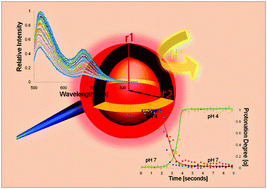
A sol–gel organosilane capsule has been compared with its ‘filled’ particle analogue and shows a faster response time
Soluble chemical sensing agents used for intracellular sensing and imaging generally have a fast response time, potentially allowing real-time measurements. When directly exposed within the intracellular environment, however, their cytotoxicity, protein binding and intracellular sequestration can result in unreliable measurements.
To tackle these problems, optrodes for the detection of analytes have been transformed into microsphere-based sensors so both the reagent and the cell are protected, whilst multiple sensing agents can be reliably positioned.
In work supported by an EPSRC/RSC Analytical Studentship, Jamie Walters and Prof. Lisa Hall of Cambridge University explored a spherical sensor geometry that could improve response time. They report a hollow 3 mm sensing microcapsule containing chromoionophores within a 100 nm organosilica shell, which shows a response time that is two orders of magnitude faster than ‘filled’ sensing particles of similar diameter.
The capsules show great potential for use in existing sensing platforms for analysis such as microfluidic devices, cytometry and waveguides.
Read the paper using the link below – it is currently free to access.
An optrode particle geometry to decrease response time
Jamie D. Walters and Elizabeth A. H. Hall
Analyst, 2011, Advance Article
DOI: 10.1039/C1AN15336F










